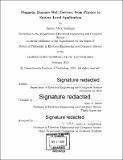| dc.contributor.advisor | Marc A. Baldo. | en_US |
| dc.contributor.author | Siddiqui, Saima Afroz. | en_US |
| dc.contributor.other | Massachusetts Institute of Technology. Department of Electrical Engineering and Computer Science. | en_US |
| dc.date.accessioned | 2019-07-17T20:58:14Z | |
| dc.date.available | 2019-07-17T20:58:14Z | |
| dc.date.copyright | 2019 | en_US |
| dc.date.issued | 2019 | en_US |
| dc.identifier.uri | https://hdl.handle.net/1721.1/121727 | |
| dc.description | Thesis: Ph. D., Massachusetts Institute of Technology, Department of Electrical Engineering and Computer Science, 2019 | en_US |
| dc.description | Cataloged from PDF version of thesis. | en_US |
| dc.description | Includes bibliographical references. | en_US |
| dc.description.abstract | Spintronics promises intriguing device paradigms where electron spin is used as the information token instead of its charge counterpart. Spin transfer torque-magnetic random access memory (STT-MRAM) is considered one of the most mature nonvolatile memory technologies for next generation computers. Spin based devices show promises also for beyond-CMOS, in memory computing and neuromorphic accelerators. In the future cognitive era, nonvolatile memories hold the key to solve the bottleneck in the computational performance due to data shuttling between the processing and the memory units. The application of spintronic devices for these purposes requires versatile, scalable device design that is adaptable to emerging material physics. We design, model and experimentally demonstrate spin orbit torque induced magnetic domain wall devices as the building blocks (i.e. linear synaptic weight generator and the nonlinear activation function generator) for in-memory computing, in particular for artificial neural networks. Spin orbit torque driven magnetic tunnel junctions show great promise as energy efficient emerging nonvolatile logic and memory devices. | en_US |
| dc.description.abstract | In addition to its energy efficiency, we take advantage of the spin orbit torque induced domain wall motion in magnetic nanowires to demonstrate the linear change in resistances of the synaptic devices. Modifying the spin-orbit torque from a heavy metal or utilizing the size dependent magnetoresistance of tunnel junctions, we also demonstrate a nonlinear activation function for thresholding signals (analog or digitized) between layers for deep learning. The analog modulation of resistances in these devices requires characterizing the resolution of the resistance. | en_US |
| dc.description.abstract | Since domain wall in magnetic wires is the nonvolatile data token for these devices, we study the spatial resolution of discrete magnetic domain wall positions in nanowires. The studies on domain wall is further extended to identify energy-efficient and dynamically robust superior magnetic material for ultra-fast and efficient devices for neuromorphic accelerators. | en_US |
| dc.description.statementofresponsibility | by Saima Afroz Siddiqui. | en_US |
| dc.format.extent | 175 pages | en_US |
| dc.language.iso | eng | en_US |
| dc.publisher | Massachusetts Institute of Technology | en_US |
| dc.rights | MIT theses are protected by copyright. They may be viewed, downloaded, or printed from this source but further reproduction or distribution in any format is prohibited without written permission. | en_US |
| dc.rights.uri | http://dspace.mit.edu/handle/1721.1/7582 | en_US |
| dc.subject | Electrical Engineering and Computer Science. | en_US |
| dc.title | Magnetic domain wall devices : from physics to system level application | en_US |
| dc.type | Thesis | en_US |
| dc.description.degree | Ph. D. | en_US |
| dc.contributor.department | Massachusetts Institute of Technology. Department of Electrical Engineering and Computer Science | en_US |
| dc.identifier.oclc | 1102049051 | en_US |
| dc.description.collection | Ph.D. Massachusetts Institute of Technology, Department of Electrical Engineering and Computer Science | en_US |
| dspace.imported | 2019-07-17T20:58:12Z | en_US |
| mit.thesis.degree | Doctoral | en_US |
| mit.thesis.department | EECS | en_US |
